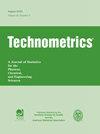填充输出空间的顺序设计
IF 2.5
3区 工程技术
Q1 STATISTICS & PROBABILITY
引用次数: 1
摘要
填充空间设计是计算机实验中常用的一种填充输入空间的设计,可以准确地估计输入-输出关系。然而,在某些应用中,如逆设计或基于特征的建模,其目的是填充响应或特征空间。在本文中,我们提出了一个新的实验设计框架,旨在填补输出(响应或特征)的空间。该设计是自适应和无模型的,因此期望对不同类型的建模选择和输入输出关系具有鲁棒性。算例表明了该方法相对于传统的输入空间填充设计的优越性。本文章由计算机程序翻译,如有差异,请以英文原文为准。
Sequential Designs for Filling Output Spaces
Space-filling designs are commonly used in computer experiments to fill the space of inputs so that the input-output relationship can be accurately estimated. However, in certain applications such as inverse design or feature-based modeling, the aim is to fill the response or feature space. In this article, we propose a new experimental design framework that aims to fill the space of the outputs (responses or features). The design is adaptive and model-free, and therefore is expected to be robust to different kinds of modeling choices and input-output relationships. Several examples are given to show the advantages of the proposed method over the traditional input space-filling designs.
求助全文
通过发布文献求助,成功后即可免费获取论文全文。
去求助
来源期刊

Technometrics
管理科学-统计学与概率论
CiteScore
4.50
自引率
16.00%
发文量
59
审稿时长
>12 weeks
期刊介绍:
Technometrics is a Journal of Statistics for the Physical, Chemical, and Engineering Sciences, and is published Quarterly by the American Society for Quality and the American Statistical Association.Since its inception in 1959, the mission of Technometrics has been to contribute to the development and use of statistical methods in the physical, chemical, and engineering sciences.
 求助内容:
求助内容: 应助结果提醒方式:
应助结果提醒方式:


